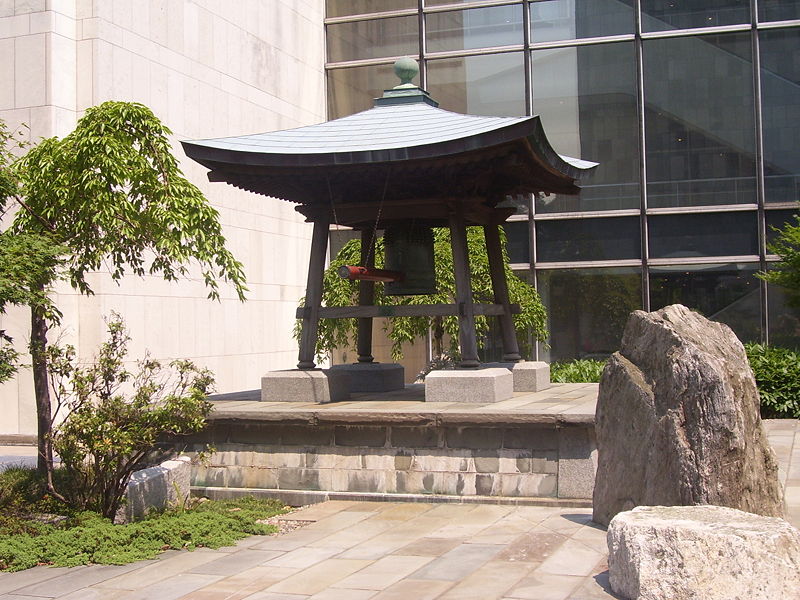How Chiyoji Nakagawa Became a Soldier for Peace and Changed the World
This is a transcript of a story told by Nakagawa’s daughter, Seiko Takase (Representative Director, Association for the Preservation of the UN Peace Bell), on a Zoom call held on behalf of the Earth Society Foundation, of which OBS President Laura Fillmore is Co-Chair.

The Japanese Peace Bell at the United Nations Headquarters in New York City.
During World War II, Chiyoji Nakagawa (1905-1972) was a Second Lieutenant in the Japanese Army, stationed in Burma (now Myanmar). He saw so many people suffer and die in the war, and it caused him great pain. But he was no ordinary officer. He dared to break the rules. He asked his men to keep three promises while serving Japan in Burma:
- Do not kill
- Do not steal
- Do not violate women
Amazingly, his troops kept those promises. In gratitude, Burmese citizens brought his men carts of food, leaving the wagons outside their camp in the middle of the night, thankful that those soldiers did not behave like other Japanese troops. But Chiyoji Nakagawa’s men paid with their lives for keeping their promises of peace: his entire division was assaulted, and during a single onslaught, all his subordinates died. Nakagawa too was left for dead, and lost consciousness.
But then he awoke. When he realized he was alive, and his men, dead, he felt terrible agony. He made his way back to Japan, a broken man determined to change things. He decided that, for the rest of his life, he would do nothing but work and pray for Peace in the world. He would do everything he could to prevent war from ever again seizing control of men’s hands and minds. But how could he do that?
He could talk to many, many people about the need for Peace. But words are evanescent; words disappear. He needed to put his quest for Peace into an object, a symbol that would last forever; and so he decided to forge a Peace Bell. One man alone, with no sponsors or backing, traveled to 140 countries to gather materials for his Peace Bell, to preach, and to listen to people about permanent Peace through avoidance of war. He gathered military medals and coins from every corner of the world. People listened, they gladly participated, and the media covered his venture. With memories of death and horror so fresh, people freely gave their medals and coins to Chiyoji Nakagawa for his Peace Bell.
He travelled to schools left standing in Hiroshima and Nagasaki to give lectures about Peace, and the people were moved. They wanted to help with the project. Each schoolchild gave Chiyoji Nakagawa a cent piece for him to forge into his Peace Bell. They also gathered soil contaminated by the atomic bombs that had incinerated within minutes their cities and their loved ones; that soil would one day form the base under the Peace Bell at the United Nations Headquarters in New York City. They gave so that people would never forget, and Peace would reign.
The work was very hard. In 1951, after the war was over but the wounds were still raw, Japan was an occupied country. Japanese people were treated as the enemy of the world. Losers. They were in a bad situation. Chiyoji Nakagawa invited himself to the Sixth Annual Session of the U.N. General Assembly in Paris as an observer. Though he later served as mayor of Uwajima for nine years, for his Peace Bell work, he had no formal support from his government. He was one man—one determined man. When he got to Paris, he didn’t just sit quietly and listen. He spoke to the General Assembly and apologized for the War that Japan had caused, declaring that the Japanese people now felt determined to avoid war at all costs and would devote their lives to Peace. He introduced his Peace Bell made from coins and war medals collected from all around the world, and all present applauded and voted to support his mission of Peace.
By 1954, Chiyoji Nakagawa had finished the Peace Bell. He contacted the Secretary General of the U.N., Dag Hammarskjoeld, who invited him to send the Peace Bell to a permanent home at the United Nations Headquarters. Nakagawa sent the Bell to New York, even though he did not have enough money to bring it there and donate it in person. However, seven years later, in 1961, the U.N. had a celebration and Hammarskjoeld invited Nakagawa to come to the Peace Garden and ring the Peace Bell himself for the first time. However, when he arrived in New York, instead of Peace and joy, he found great sadness and mourning: just days before his arrival, Dag Hammarskjoeld’s plane was shot down with him in it while on a Peace mission to Africa. The Peace Bell ceremony that year was small and solemn.
Nakagawa didn’t stop there: he went on to make 150 smaller replica bells, partially forged from scrapings of the original Peace Bell, which he personally delivered to the embassies of each of the 122 U.N. member nations. He implored them to work for Peace and not to start war again. They all agreed! Nakagawa continued this work throughout his life: wherever he saw danger of war and conflict, there he went with a replica Peace Bell, spreading the DNA of Peace around the world again and again. In 1961, during the Cuban Missile Crisis, he presented American President Kennedy and Soviet Premier Khrushchev with a 4kg replica of the U.N. Peace Bell, appealing to them to “never go to war again.” Each bell and each replica has gold lettering that says “世界絶対平和萬歳” (hep: sekai zettai heiwa banzai), literally, “long live absolute world peace.” The text is accompanied by the sun and the moon, is surrounded by laurel, and sits right where the wooden bell hammer meets the bell.
In 1969, Chiyoji Nakagawa borrowed the UN Peace Bell from the United Nations for the 1970 Osaka Expo. Nakagawa went on to build another 150 Peace Bell replicas, of 1 kg each, and in 1969 presented them to UN Secretary-General U Thant and the ambassadors of 141 countries in the hope of Peace. Seiko, Nakagawa’s daughter, continues to build replicas of the Peace Bell and rings it in Osaka on September 21, International Peace Day. This year, Seiko plans to fly to New York and attend the Peace Bell ceremony on March 20 at the United Nations. Following tradition, she will ring the Bell three times:
First, for God above;
Second, for God on Earth;
Third, for our Ancestors.
This year’s Peace Bell ceremony honors Earth Society co-founder Margaret Mead, who famously said: “Never doubt that a small group of thoughtful, committed citizens can change the world. Indeed, it’s the only thing that ever has.” The ceremony will also honor past Earth Society President Helen Garland. The Earth Society Foundation has invited nine children, representing the nuclear-armed nations of the world, to ring their Peace Bells at the ceremony. And this year, when the world once again careens towards the horror of nuclear war, we honor and continue the work and prayers of Chiyoji Nakagawa as we ring the Peace Bell in an effort to call mankind to its senses through Peace.
